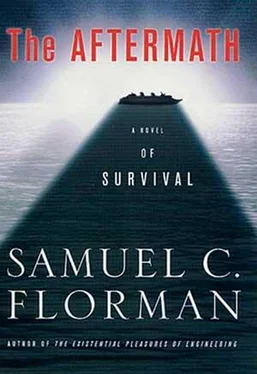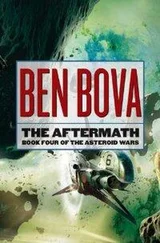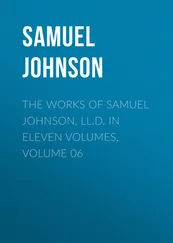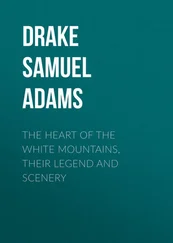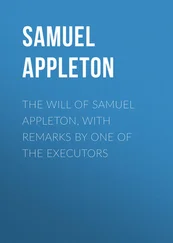Samuel Florman - The Aftermath
Здесь есть возможность читать онлайн «Samuel Florman - The Aftermath» весь текст электронной книги совершенно бесплатно (целиком полную версию без сокращений). В некоторых случаях можно слушать аудио, скачать через торрент в формате fb2 и присутствует краткое содержание. Город: New York, Год выпуска: 2001, ISBN: 2001, Издательство: Thomas Dunne books, Жанр: sf_postapocalyptic, на английском языке. Описание произведения, (предисловие) а так же отзывы посетителей доступны на портале библиотеки ЛибКат.
- Название:The Aftermath
- Автор:
- Издательство:Thomas Dunne books
- Жанр:
- Год:2001
- Город:New York
- ISBN:0-312-26652-9
- Рейтинг книги:5 / 5. Голосов: 1
-
Избранное:Добавить в избранное
- Отзывы:
-
Ваша оценка:
- 100
- 1
- 2
- 3
- 4
- 5
The Aftermath: краткое содержание, описание и аннотация
Предлагаем к чтению аннотацию, описание, краткое содержание или предисловие (зависит от того, что написал сам автор книги «The Aftermath»). Если вы не нашли необходимую информацию о книге — напишите в комментариях, мы постараемся отыскать её.
The Aftermath — читать онлайн бесплатно полную книгу (весь текст) целиком
Ниже представлен текст книги, разбитый по страницам. Система сохранения места последней прочитанной страницы, позволяет с удобством читать онлайн бесплатно книгу «The Aftermath», без необходимости каждый раз заново искать на чём Вы остановились. Поставьте закладку, и сможете в любой момент перейти на страницу, на которой закончили чтение.
Интервал:
Закладка:
Samuel C. Florman
THE AFTERMATH
A Novel of Survival
for Hannah, Lucy, Sylvie, Julia, and Rachel
FROM THE JOURNAL OF WILSON HARDY, JR.
When the comet struck, I was on a cruise with my father. It may sound ludicrous, irresponsible even, to be off on a cruise when the world blows up, but how else can I put it? That’s the way it was, just a year ago tomorrow, a date for the history books yet to be written—if we ever print books again—December 25, 2009.
Can you imagine the world being destroyed on Christmas? In olden days, when children hung stockings by the fireside expecting presents from St. Nicholas, some parents would fill the stockings of naughty kids with coal to teach them a lesson. Maybe that’s what has happened to the human race. Some lesson!
But then why, you might ask, wasn’t I incinerated, pulverized, or drowned with the rest of the human race? I guess everyone who survived has been wondering the same thing. How many of us are there? About twenty-five hundred from the cruise ship—fifteen hundred passengers and roughly one thousand crew—plus approximately twenty-five thousand people who were already residents of (he place in which we find ourselves. That is not very many out of a world population that had recently passed seven billion.
As for the Event, the odds against it ever happening in the first place are even more remarkable. The experts used to say that the chance of encountering a comet or an asteroid ten kilometers wide—like the one that hit near the Yucatan peninsula sixty-five million years ago, supposedly killing off the dinosaurs and two thirds of all other species—was once in a hundred million years.
Not only was last year’s comet larger than that infamous monster, but it was the second such projectile to come hurtling toward the earth in just two years. It makes you think that someone, or something, out there was not happy about what was going on here.
When I say out there, I should really say way out there, because that’s where comets come from—a far, far, almost unimaginably far distance. Like many people, I used to confuse comets with asteroids; but, as I now know only too well, they’re very different things. An asteroid is a solid piece of rock, sort of like a small planet. It travels around the sun in nearby circles and we can keep an eye on it—on them, for there are many thousands. A comet is more mysterious, coming from the outer reaches of the solar system, beyond the planet Pluto, formed—so the astrophysicists tell us—in a remote molecular mist called the Oort cloud.
How and why these strange entities are formed, nobody really knows. But once they take shape and start to move, they are gravitationally bound to the sun. Unlike planets and asteroids, however, they travel in extremely elongated orbits, disappearing from our view for years at a time—for centuries at a time. Some of them are familiar to us—like our good friend Halley, who shows up every seventy-five to eighty years, and whose comings and goings we can calculate with great accuracy. But others can appear at any moment, coming from any direction, and usually going undetected until they are practically upon us. I remember back in 1996, when I was in elementary school, the comet Hyakutake was first sighted less than eight weeks before it passed by the earth. Less than eight weeks! And then it came within nine million miles of the earth—a tenth of the distance between the earth and the sun—practically a stone’s throw in cosmic terms.
Studies have shown that the nucleus of a comet consists of sand and small bits of rock, embedded in ice, mostly frozen water, but also frozen gasses such as carbon dioxide, methane, and ammonia.
As this dirty snowball enters the central part of the solar system, the sun’s heat vaporizes some of the ices, creating the spectacular coma, or “tail.” A big asteroid can do just as much damage as a big comet. But the comet, vividly aglow like an avenging angel, has a more fearsome aspect.
Yet, when I think back to before the Event, fear hardly entered the picture. That may seem hard to believe. But the first comet was handled so effectively, with near-pinpoint nuclear blasts, that it looked as if the problem was nicely under control, now and forever. The technique had been worked out carefully, first in computer modeling, then in testing with nearby asteroids. The concept was simple enough—just a slight nudge to a charging assailant, sort of a technological judo maneuver. But the geometry of interception had to be exact, the timing had to be exquisitely precise, and the power of the bombs had to be increased far beyond anything previously employed.
Early in the new millennium, the U.S. Congress—at the request of a new president and with months of political debate and horse trading—had authorized the Department of Defense, NASA, and the Department of Energy to proceed on a crash program of intercept technology, using ion propulsion rockets, massive new computers, improved radar and lasers, and radically new techniques for nuclear explosion. One feature of the new methodology was to use the neutron flux from the bomb explosion to heat a portion of the surface of the intruder. The suddenly heated surface layer would blow away from its home sphere, generating a powerful recoil. This, plus the force of the nuclear blast itself, would achieve the desired change in direction. Until it all worked with a genuine threat, a certain amount of trepidation was inevitable. But, with that first comet, everything functioned perfectly. It was, as they say, a piece of cake.
When the time came, the Americans and the Russians each sent two nuclear bombs out into space and exploded them together near the monstrous mass, nudging it to one side, sending it harmlessly off on a slightly altered course. One bomb would have done the trick, but using four was part of an elaborate fail-safe program. It also provided a political and public relations bonanza for the governments of both nations, along with acclaim for the engineers, scientists, and military leaders who led the effort.
When the second comet was sighted a few months later, there was hardly any public anxiety at all, merely anticipation of another exciting media event. Our cruise was already planned, and there wasn’t any discussion about canceling it. On our luxury ship we would be able to get all the news via television and the wireless Internet, and thus not miss any of the excitement.
A few people in our group, members of the American Institute of Aeronautics and Astronautics, had to drop out because of their work with NASA, both as full-time employees and as consultants. Although the methodology for diversion of comets and asteroids was now established and tested, the agency nonetheless wanted all its people on hand. Nobody else on the passenger list thought that there was even the remotest reason to change plans.
I guess I haven’t mentioned that our cruise was being held to commemorate the thirtieth anniversary of the American Association of Engineering Societies—AAES—which meant that many of the fifteen hundred passengers were engineers of one sort or another. To be more specific, about six hundred of the passengers were engineers, the other nine hundred spouses, significant others, and children of engineers. That’s where I come in.
Call me Ishmael. No, I’m just kidding. My name is Wilson Hardy, Jr.—known to friends as Wil, with a single “L”—and I was born and raised in Atlanta. But when I think about bearing witness to an appalling disaster, I cannot help but think about Melville’s great American novel, and Ishmael: the survivor as narrator. We were discussing Moby Dick in a graduate school seminar at Georgia Tech, just before I left for Christmas vacation last year. Actually, I left Atlanta several days early in order to go on the cruise. I was worried about falling behind in my work. That’s a laugh. I guess I won’t have that Ph.D. to hang on the wall. In fact, I’m lucky to have a wall…
Читать дальшеИнтервал:
Закладка:
Похожие книги на «The Aftermath»
Представляем Вашему вниманию похожие книги на «The Aftermath» списком для выбора. Мы отобрали схожую по названию и смыслу литературу в надежде предоставить читателям больше вариантов отыскать новые, интересные, ещё непрочитанные произведения.
Обсуждение, отзывы о книге «The Aftermath» и просто собственные мнения читателей. Оставьте ваши комментарии, напишите, что Вы думаете о произведении, его смысле или главных героях. Укажите что конкретно понравилось, а что нет, и почему Вы так считаете.
